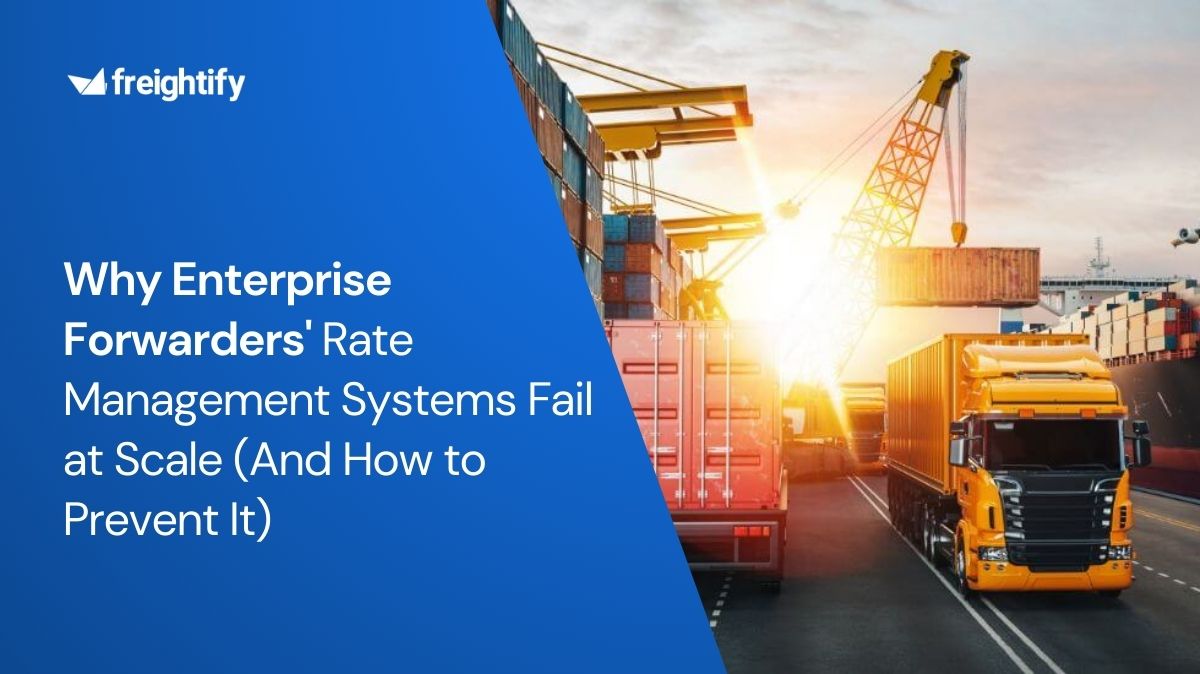Over the past few decades, technological advancements have influenced how businesses operate. Companies have had to revise and restructure their processes while adopting digital growth.
The logistics industry has been no different. Solutions with an automated mechanism have been the norm in almost every avenue. There is no dearth for expansion from drones and robots to tracking devices and documentation libraries by implementing artificial intelligence, blockchain, and the internet of things (IoT).
The rate management solution is vital for freight forwarders to work smarter instead of working harder. The benefits of automating the manual freight forwarding processes have been explored in our previous blog post .
This article will delve into the details of the top 10 features that you should look for before buying a rate management system for your logistics business.
Let us help you with your journey
Search and Filter Spot and Contract Rates Instantly using Multiple Parameters!
Ease of use The prime reason for going digital was to ensure that every stakeholder involved in the freight forwarding process can utilize their time efficiently without worrying about manually tracking every rate, quote, schedule, fee, and price.
Hence, ease of use tops the list of critical features in an RMS tool.
Considering that this tool would be used across the globe, it should contain a standardized structure that is easy to use and should also be compatible with all platforms to garner a larger reach. Ultimately, the look and feel of the software should bring customers back for more business.
Transparency and reliability A customer would want to transparently know what charges he pays for during the transportation process. Similarly, freight forwarders would require reliable data from carriers to create quotes accordingly.
The future of logistics requires transparency while dealing with large numbers of vendors, transporters, clients, agents, clearinghouses, and forwarders.
From being able to plan routes to optimize prices, a transparent flow of data is essential. The data shared or reported needs to be transparent and reliable even within the business. These basic attributes create the base for the future of logistics .
Coverage and network One of the most important functions that a freight forwarder automates while switching to a rate management tool is identifying the live spot rates. This rate is the base for the entire transaction – from the quotation until the invoicing step.
Providing wide coverage of rates from carriers will be critical for freight forwarders. The relationship is proportionate – the larger the network that the RMS tool developer has, the forwarder has a larger chance to convert the sales leads.
Hence, it would make sense to check the variety of carriers and currencies that the RMS tool can support before choosing the right fit.
Visibility and speed The cumbersome freight forwarding process is a time-driven sector. If the software used to automate manual processes cannot perform a task in less time, it loses the essence of being an automation tool. Hence, speed functionality is a significant factor while creating a trustworthy RMS solution.
Similarly, the extent of visibility provided by cutting across organizations should also be considered. The RMS tool should solve (to some extent) the structural problems that fragmentation has caused. Through strategic collaborations and prime partnerships, visibility can be enhanced .
Privacy and audit logs Regardless of the sensitivity, data needs to be stored with privacy. Legal reforms like the GDPR rules have exhaustive guidelines for storing, using and discarding data.
The partnering RMS solution provider should understand the concept of data privacy and create a solution that truly secures confidential information. The types of people who have access to edit information within an RMS tool need to be deliberated on.
Similarly, changes to the data within the tool need to be tracked systematically. An audit log can help track what information was changed, when, and whom. This provides a layer of security over the information that the tool contains.
Flexibility and scalability This is true of just about any software. The platform should allow users to make quick and easy changes. This could be measured by testing a software's ability to change easily in response to different user and system requirements.
Additionally, all businesses are bound to grow – and while they move up the economic ladder, they would hope that the software they depend on travels with them.
Hence, the RMS platform being implemented should have the scope to scale into a larger product.
Analysis and reporting options Having reliable information that cannot be consumed appropriately could lead to massive lapses in judgment. The RMS solution should go beyond a simple rate-and-quote facilitator and number-crunch the available data.
The tool should provide trends and analysis that help with informed decision-making. By taking advantage of big data models, easily generatable reports must be developed for both the customers and the freight forwarder.
Reports can go one step further and convert scores of numbers into visually appealing data charts. Customizing these numeric and pictographic reports could also be a game-changer.
API Integration and portability The API feature would incorporate data from carriers in a single and easy format. Live data changes would happen automatically using universally accepted API Standard formats for quick integration.
Additionally, porting data across tools should provide a seamless operational environment. Most forwarders already utilize other systems and tools for their operational and finance activities.
Instead of relying on multiple tools that do not interface with each other, the benefits of having a single platform with all data are greater. Hence, RMS solutions that provide TMS and API integration will have an added edge.
Cargo tracing capacity While most of the RMS solution's focus revolves around getting the rates and quotes accurate, another major concern in today's freight industry is the time it takes to transport cargo.
A staggering 25% of global vessels are delayed. During the pandemic, 77% of the world's cargo experienced an abnormally long wait time.
Hence, for customers to plan upfront for any possible delays and to manage their operations better, they would require an integrated option that lets them track their cargo with live information. RMS tools should also have the functionality to provide automated updates based on a vessel's location and milestone.
Allied products In today's digitized age, software usually provides allied services or products that can add to the armor of personalized offerings that a freight forwarder can provide. In this case, beyond the traditional rate management solution, the possibility of creating a customer portal and a website within the tool allows forwarders to build their business in a streamlined manner.
The ultimate goal is to create a one-stop system to enable and deliver online sales of forwarding services.
Supplementary considerations The components that make a winning rate management system do not stop with this. A few more factors need to be present to teach the essence of a personalized forwarding business with digital up-gradation.
While building the relationship with an RMS tool service provider, the relationship between both parties is vital for the enterprise's success. From software maintenance to technical troubleshooting, the forwarder will rely on the software developer for guidance and expertise. Hence, it is ideal to proceed with developers that can forge long-term relationships within the logistics industry.
Additionally, other nuances like the brand that has built the solution to the cost-effectiveness impact. Digital innovation must not be radically expensive that it off-shoots budgets and increases operating costs. Finding the balance between these crucial factors and the cost is key.
Let us help you with your journey
Improve your margins by finding best pricing among spot and contract rates!
The Freightify solution The plug-and-play rate management solution that Freightify has built has digitalized every manual forwarding activity right from rate procurement to quote generation.
Further, the time saved in addition to the cost saved allows for time and efforts to be utilized better and generate more leads. The usage of the Freightify rate management system will assist with the economics behind the business operations to become more prudent.
Every one of the top ten factors that makes a winning rate management system can be evidenced in the Freightify solution.
As a SaaS service provider, Freightify aims to enable freight forwarders to deliver a better experience without worrying about data reliability and information flow. By cutting through layers of people, removing redundant information, and eliminating unnecessary barriers, the Freightify resolution reverberates profitable progress for the freight forwarders.
FAQ What is a rate management system? A rate management system is a digital tool (usually a SaaS model) that assists freight forwarders in consolidating, optimizing, and streamlining the flow of contracts and rates coming in from various providers and going to their customers. This enables their main Unique Selling Proposition as a balanced multi-carrier provider. The underlying use of this solution is to help forwarders in the logistics industry to understand better and control their purchasing and selling functions (from rate procurement to quotation stage, including rate management)
Who is benefited from an automated rate management system? As the RMS tool is integrated with all major carriers and can translate data across formats to provide updated prices, freight forwarders in the logistics industry who work across time zones and borders benefit the most.
Is building an RMS solution much more feasible than buying one? Building an RMS solution from scratch is complicated. Technical codes, server allocation, front-end user experience, back-end database management, privacy concerns, and continued system upkeep require a niche knowledge that forwarders might need to invest in. It is more beneficial and cost-effective to adapt an existing RMS solution provider like Freightify instead of setting up an RMS tool.
Studies suggest that the supply chain industry lacks collaboration across its stakeholders. The future outlook to logistics is to inculcate a global partnership across its members. For such a joint effort, transparency is key. With increased transparency, risks can be mitigated, and trust can be won. Similarly, effective routes can be planned, and operations can be streamlined. This level of visibility provides supply chain stakeholders with vast volumes of data that can be used for sustainable growth and continuous improvement.
Why is it essential to go for a cloud-based logistics software solution? Cloud computing provides fast, reliable, and flexible data storage and data processing opportunities that can be ported and scaled quickly. All of these features help streamline complicated tasks that forwarders are involved in. A dedicated cloud-based freight forwarding solution (SaaS) allows freight forwarders to answer queries, track cargo, optimize routes and send notifications to customers minutes before executing a delivery. These opportunities decrease the levels of uncertainty in the forwarding business.




















